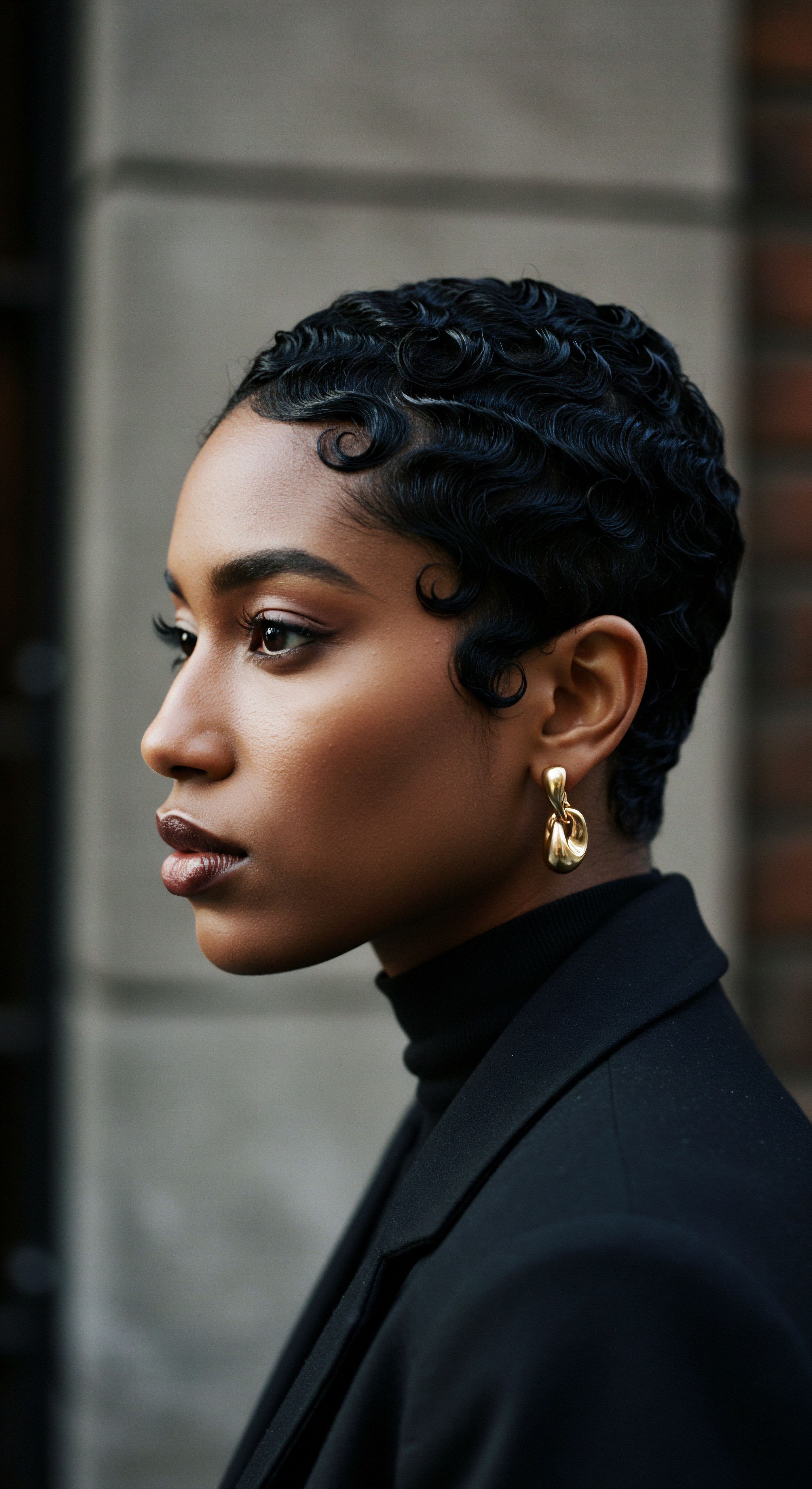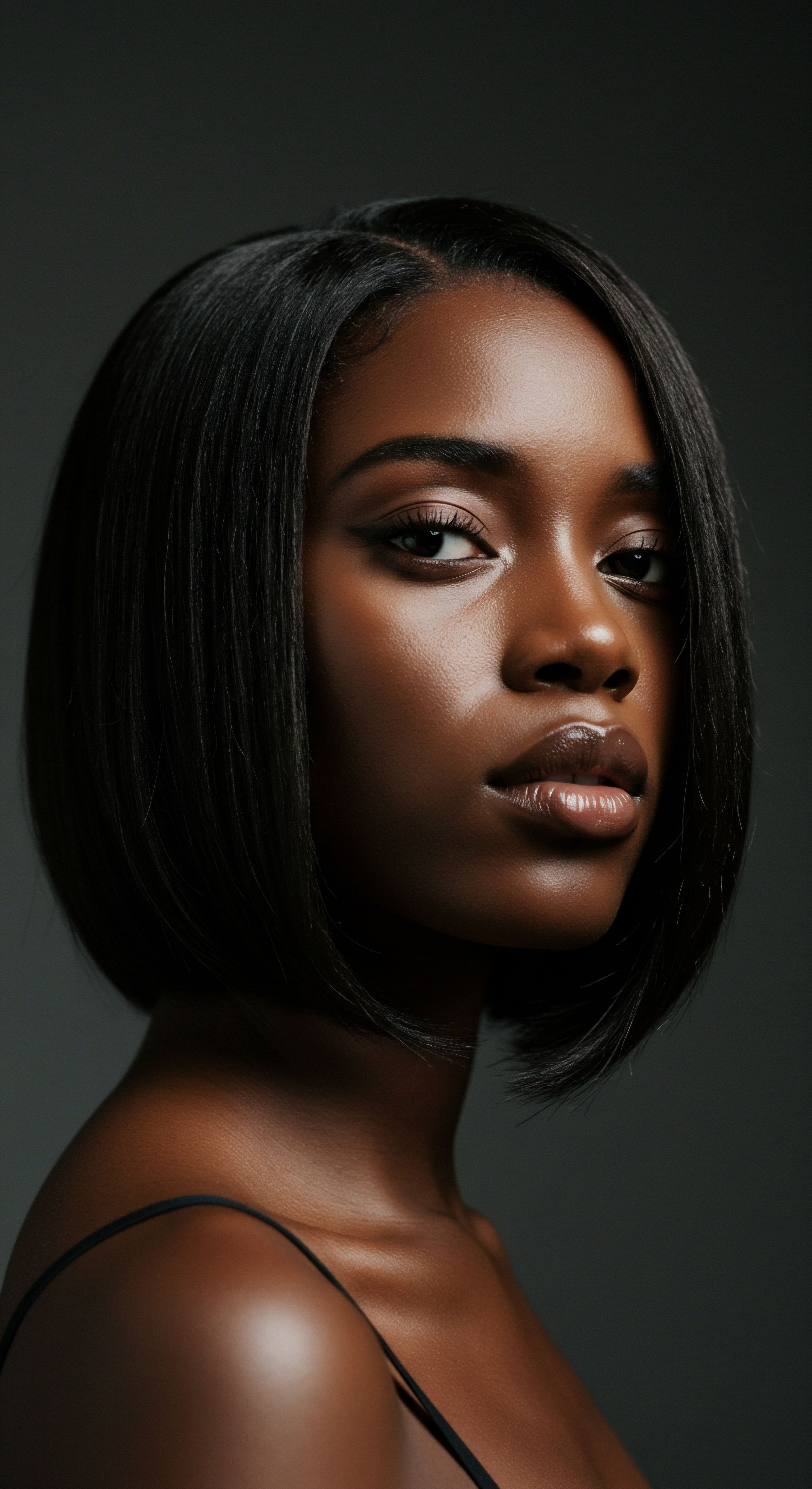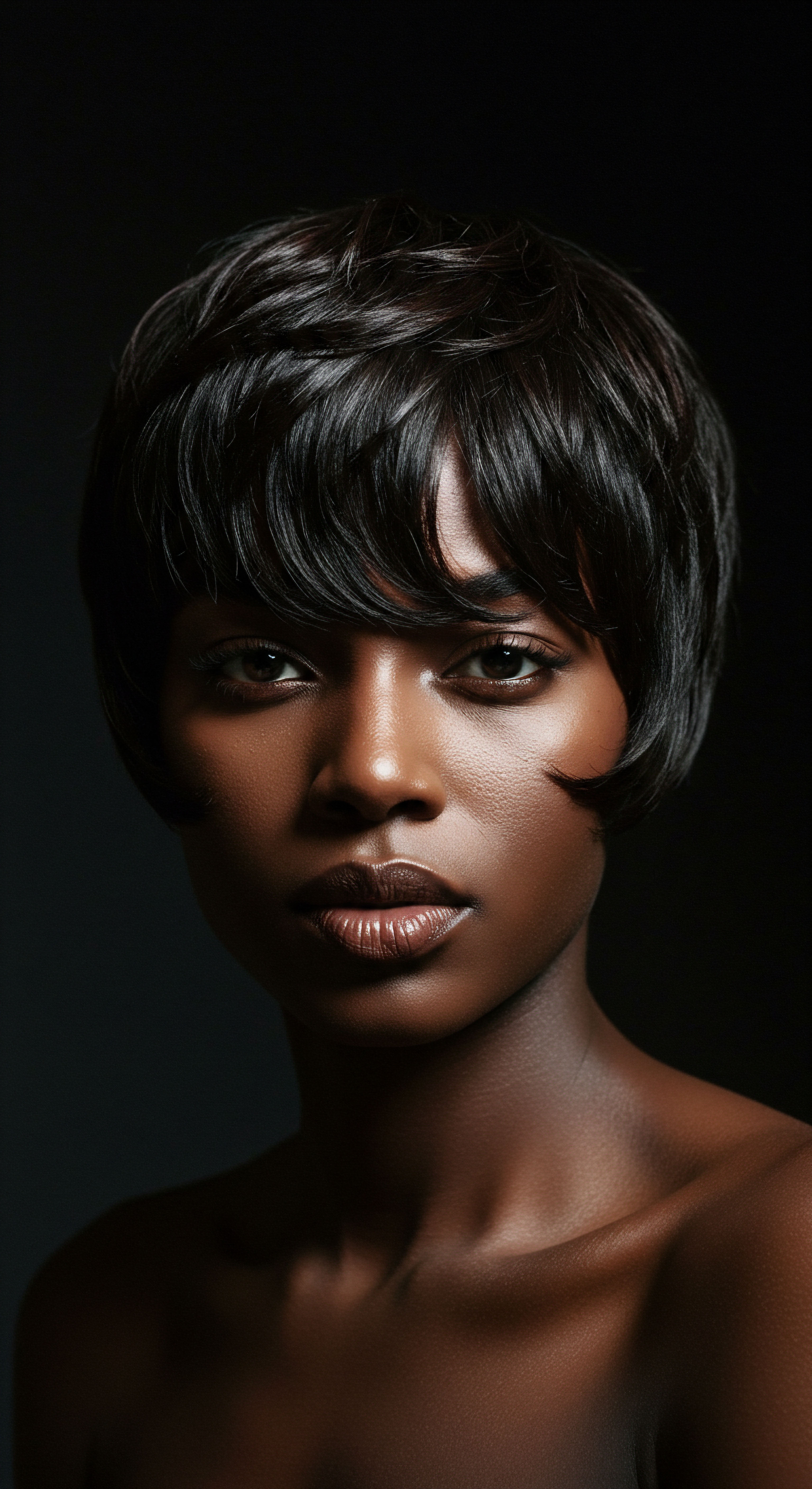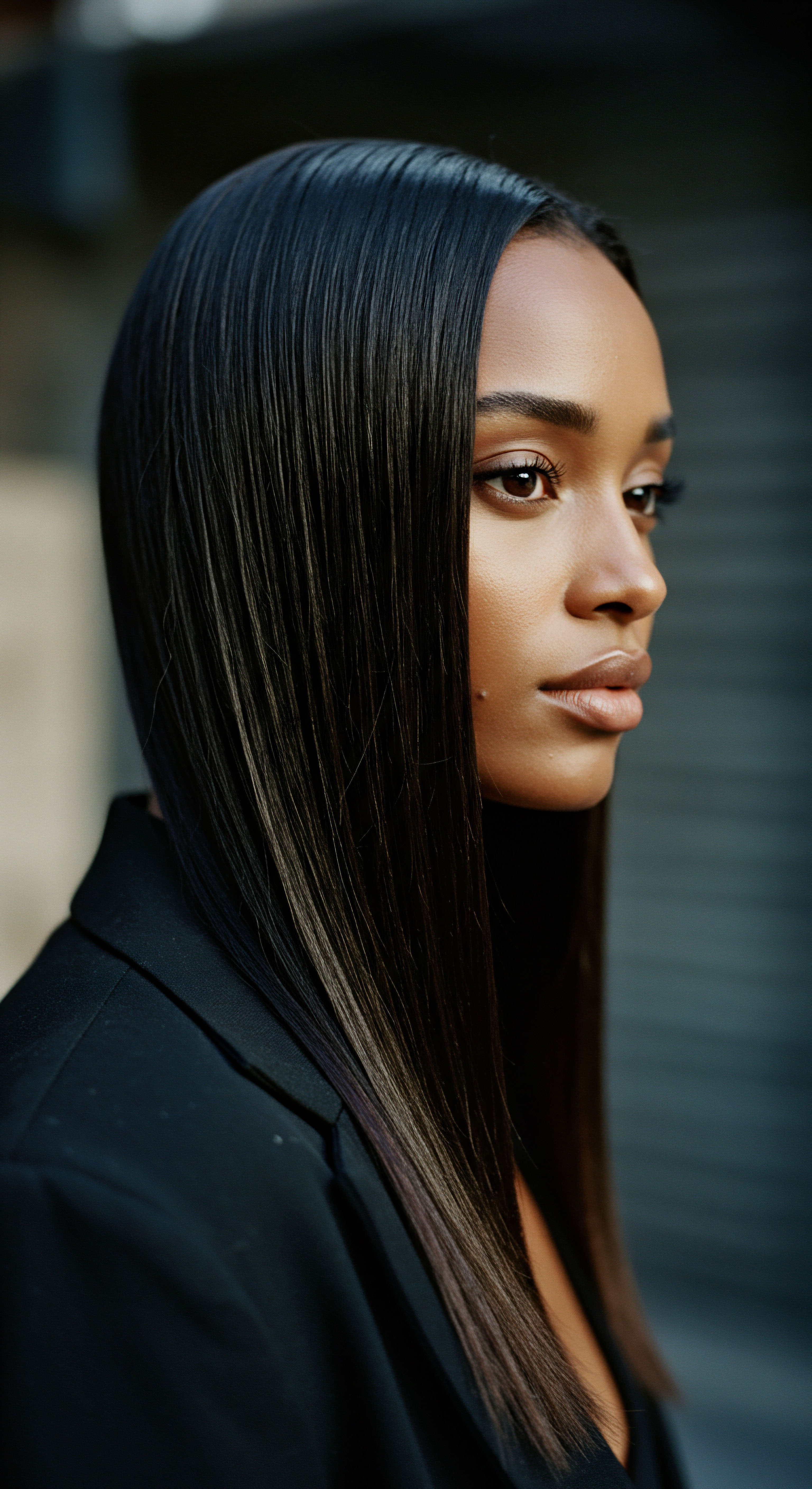
Roots
The very act of tending to one’s hair, a seemingly simple gesture, holds echoes of ancient wisdom, a quiet conversation across centuries. Long before bottles lined our shelves, before the language of cosmetic chemistry took hold, people around the globe turned to the earth’s bounty, to the rich yield of seeds and fruits, to care for their strands. This reliance on oils was not merely a happenstance; it was a deep recognition of their inherent ability to protect, to soothe, and to bring forth a natural sheen. These early practices form the bedrock of our understanding, a foundational layer of knowledge that continues to resonate with those seeking gentle, profound care for textured hair.

The Earliest Anointments
Across diverse landscapes, the earliest civilizations discovered the profound properties of oils. In ancient Egypt, for instance, historical accounts suggest that both men and women regularly used oils extracted from plants such as Castor, Sesame, and Moringa for skin and hair care. Queen Cleopatra, a figure synonymous with beauty, reportedly incorporated olive oil into her daily regimen for its nourishing qualities.
These oils were not just for aesthetics; they served a practical purpose in the harsh desert climate, shielding hair from environmental damage and providing a protective barrier. The use of natural waxes, like beeswax, also found its place in ancient Egypt, offering hold and shine while adding a layer of defense to the hair.
Moving to the Mediterranean, the Greeks and Romans revered olive oil, considering it a sacred liquid. It was a staple in their hair care, valued for its moisturizing abilities. They often infused olive oil with aromatic herbs, such as rosemary and lavender, to enhance its properties and create fragrant conditioners. This practice highlights an early understanding of botanical synergies, where the benefits of various plant elements were combined for greater effect.

What Did Ancient Cultures Use for Hair Care?
Different regions, shaped by their unique flora, developed distinct oil-based hair care traditions.
- African Traditions Castor oil, native to the Ethiopian region, was a prized staple in African hair and body care for centuries, used to treat various skin, scalp, and hair conditions. In some areas of ancient and medieval Africa, it held higher regard than sesame or olive oil. Shea butter, derived from the karite tree, also played a significant role in West African traditions, used to moisturize hair in hot, dry climates, often alongside protective styles. These natural emollients were essential for maintaining hair health in challenging environments.
- Asian Traditions The Indian subcontinent, with its rich Ayurvedic traditions, relied heavily on oils like Sesame and Coconut. These were used for both medicinal and spiritual practices, with Ayurvedic texts like the Charaka Samhita documenting their significance in promoting hair and skin health. The practice of hair oiling, or ‘Champi,’ deeply rooted in Ayurveda, dates back thousands of years, with warm herbal oil applied and massaged into the scalp to nourish and strengthen hair. In Japan, camellia oil (Tsubaki oil), rich in oleic acid, was applied to hair to maintain its straightness and shine, a practice dating back to the Edo Period. Chinese traditions also utilized hair oils made from wood or sesame oil and animal fat to create elaborate hairdos and signify social status.
- Indigenous American Practices Jojoba oil, technically a liquid wax, was discovered and used by the Indigenous American Tohono O’odham people centuries ago. Native American tribes utilized it as a balm for hair, skin, and minor wounds, valuing its moisturizing properties. Its chemical structure, remarkably similar to human sebum, allowed it to hydrate hair without leaving a greasy residue.
The global journey of oil-based hair care began with ancient civilizations recognizing the earth’s natural emollients for protection, cleansing, and adornment.

Ritual
Stepping from the ancient whispers of initial discovery into the rhythmic practices of daily life, we observe how oil-based hair care became less a fleeting act and more a cherished ritual. This transition speaks to a deeper understanding of hair as a living extension of self, deserving of consistent, intentional care. It is within these routines that the practical wisdom of our forebears truly comes alive, guiding us toward techniques that honor hair’s unique textures and needs.

Daily Anointing and Weekly Ceremonies
The application of oils transcended simple grooming; it became a mindful practice, often steeped in cultural significance. In South Asian households, hair oiling remains a generational custom, often beginning in childhood. Elders massage oil into the scalps of younger family members, a quiet moment of connection and care.
This tradition underscores a belief that consistent oiling fortifies strands, prevents breakage, and promotes long-term hair health. The Sanskrit word for oil, ‘sneha,’ also translates to ‘to love,’ highlighting the tender, intentional nature of this practice.
For instance, in traditional Ayurvedic practices, the ritual of daily oiling aimed not only to rejuvenate and maintain hair health but also to enhance spiritual well-being through the absorption of potent plant essences via the scalp. Specific oils were chosen for different seasons or hair concerns; sesame oil might be favored in winter, while coconut oil, with its cooling properties, was recommended for warmer months.

What Did Rituals Mean for Hair Health?
Beyond simple application, the rituals often involved specific techniques and considerations for hair health.
- Scalp Stimulation Many traditions emphasized massaging oils into the scalp. This practice was believed to stimulate blood circulation, which in turn could promote hair growth and improve the health of hair follicles. In Middle Eastern households, scalp massages with oils were often accompanied by moments of self-care and relaxation.
- Protective Measures Oils and butters were particularly significant in West African traditions, used to keep hair moisturized in hot, dry climates. These applications were frequently paired with protective styles to maintain length and health, acting as a shield against environmental stressors. Similarly, Arabian women often covered their hair with silk scarves or hijabs after oiling, not only to shield it from sun and dust but also to help retain moisture and prevent dryness.
- Infusion and Customization Ancient hair care was rarely a one-size-fits-all approach. Herbal oils, infused with botanicals like hibiscus, amla, sage, rosemary, or fenugreek, were common. These infusions allowed for tailored treatments, addressing concerns such as dandruff, hair loss, or dullness. For example, in the Indian practice of Champi, practitioners would assess hair health to select the appropriate treatment oils, perhaps using castor oil for damaged hair or sesame oil for a dandruff-prone scalp.
Oil-based hair care transcended mere grooming, evolving into culturally significant rituals of nourishment, protection, and intergenerational bonding.
The careful selection of oils and the method of their application reveal a sophisticated, intuitive understanding of hair’s needs. The emphasis on massaging, infusing, and protecting demonstrates a deep connection to the material world and a reverence for the body’s natural rhythms. These traditions were not simply about appearance; they were about holistic well-being, where external care mirrored internal balance.
| Region Ancient Egypt |
| Common Oils Castor, Sesame, Moringa, Olive |
| Primary Use in Rituals Protection from climate, shine, medicinal uses |
| Region Greece and Rome |
| Common Oils Olive (often herb-infused) |
| Primary Use in Rituals Conditioning, fragrance, scalp nourishment |
| Region South Asia (India) |
| Common Oils Coconut, Sesame, Amla, Neem, Castor |
| Primary Use in Rituals Ayurvedic practices, scalp health, spiritual well-being, bonding |
| Region West Africa |
| Common Oils Shea Butter, Coconut, Castor, Animal Fats |
| Primary Use in Rituals Moisturization in dry climates, protective styling |
| Region Middle East |
| Common Oils Argan, Olive, Jojoba, Black Seed |
| Primary Use in Rituals Nourishment, frizz control, shine, cultural heritage |
| Region Indigenous Americas |
| Common Oils Jojoba, Castor |
| Primary Use in Rituals Balm for hair and skin, scalp care, medicinal |
| Region Japan |
| Common Oils Camellia (Tsubaki) |
| Primary Use in Rituals Maintaining straightness, shine, spreading natural oils |

Relay
As we move beyond the familiar practices, a more intricate understanding of oil-based hair care begins to unfold, revealing how scientific intuition converged with cultural expression over millennia. The transmission of these traditions, a quiet relay race across generations and continents, often carries subtle complexities that demand closer examination. It is here, at the intersection of ancestral knowledge and modern inquiry, that we discern the deeper mechanisms and societal implications of these enduring customs.

How Do Historical Practices Inform Modern Hair Science?
The efficacy of many traditional oil-based hair care practices finds grounding in contemporary scientific understanding. For instance, the widespread historical use of Coconut Oil in South Asia and tropical regions is now supported by research indicating its high lauric acid content. This unique fatty acid has a low molecular weight and a linear structure, allowing it to penetrate the hair shaft more effectively than many other oils. A 2003 study, for example, demonstrated that coconut oil applied as a pre-wash treatment significantly reduces protein loss in both damaged and undamaged hair.
This is a noteworthy point, considering that keratin protein makes up approximately 80% of hair’s structure, and its loss contributes to breakage and overall weakening. The ancient practice, therefore, aligns with a precise biochemical interaction, illustrating an intuitive grasp of hair’s fundamental composition.
Similarly, Jojoba Oil, prized by Indigenous American communities, is not truly an oil but a liquid wax ester. Its chemical composition closely resembles that of human sebum, the natural oil produced by our scalp. This biomimicry allows jojoba oil to balance the scalp’s natural oil production, offering hydration without excessive greasiness and helping to regulate conditions like flakiness. This property, recognized intuitively by ancient users, provides a scientific basis for its continued relevance in hair care, particularly for those with textured hair who seek balance and moisture without heavy build-up.

What Societal Meanings Did Hair Oils Carry?
Beyond their physiological benefits, oil-based hair care practices often held profound societal and cultural meanings, acting as markers of identity, status, and even resistance.
In many ancient societies, hair was a powerful symbol. In Egypt, elaborate headdresses and wigs, often prepared with oils, denoted power and social standing. For Roman women, hairstyles, often conditioned with olive oil, could indicate belonging to specific social classes.
In ancient China, the way women styled their hair with oils, from loose to coiled updos, conveyed their class status and role within the family hierarchy; a bun, for instance, was reserved for married women. This highlights how the care and styling of hair, facilitated by oils, served as a non-verbal language within communities.
The cultural significance extends to expressions of identity and defiance. During the transatlantic slave trade, enslaved Africans carried their hair care practices, including the use of natural oils like Shea Butter and Coconut Oil, to moisturize and protect their hair in harsh conditions. These practices became a vital aspect of cultural expression and resilience.
Furthermore, in the 1970s, during the “Black is Beautiful” movement, the choice to use natural indigenous oils like jojoba became an act of resistance against Eurocentric beauty ideals, aligning with a broader assertion of cultural authenticity among Black communities. This historical context underscores how hair care, and the oils used within it, could symbolize agency and cultural pride against oppressive norms.
Traditional oil use in hair care is supported by modern science, with examples like coconut oil’s protein protection and jojoba oil’s sebum-like composition demonstrating ancient intuitive wisdom.
The economic aspects of hair oils also played a part. The cultivation and trade of specific oil-producing plants, such as the argan tree in Morocco or the olive tree in the Mediterranean, supported local economies and shaped cultural exchanges. The continued demand for these traditional oils in contemporary global markets speaks to their enduring value, a testament to the wisdom passed down through generations.

How Did Oil Use Change Over Time?
The evolution of oil-based hair care practices also shows adaptation and transformation across historical periods.
- From Raw to Refined Early applications involved directly extracting oils from plants. Over time, techniques for infusion with herbs and other botanicals became more sophisticated, creating specialized remedies. The Renaissance saw the emergence of pomades and scented oils, marking a shift towards more elaborate formulations for styling and fragrance, though some early methods could be harsh or even toxic, such as lead-based compounds used for hair darkening in ancient Rome.
- Ritual to Commodity While deeply rooted in ritual and community bonding, especially in South Asian and Middle Eastern cultures, oil-based hair care has also transitioned into a global commodity. The global hair oil market is projected to reach USD $3.9 billion by 2024, reflecting a compound annual growth rate of 4.78 percent during the forecast period. This commercialization, while expanding access, also raises questions about cultural recognition and ethical sourcing, particularly as practices like hair oiling gain popularity in Western societies without always acknowledging their origins.
- Integration with Modernity Today’s hair care products often combine ancient wisdom with modern science. Many formulations incorporate time-tested oils like argan, jojoba, and coconut, enhancing their efficacy with advanced cosmetic chemistry. This blend represents a continuation of tradition, adapted to contemporary lifestyles and scientific understanding, demonstrating a continuous dialogue between past and present approaches to hair health.
The historical relay of oil-based hair care is a complex tapestry of scientific discovery, cultural expression, and societal adaptation. It shows that our current approaches to hair health are not isolated innovations but rather extensions of a deep, global heritage, shaped by environmental realities, social structures, and an enduring quest for well-being.

Reflection
The gentle touch of oil on hair, whether in a communal ritual of old or a quiet moment of self-care today, carries with it the quiet strength of continuity. It reminds us that our search for healthy, radiant hair is not a modern invention but a deeply human endeavor, one that has spanned continents and epochs. The whispers of ancient Egyptians anointing their locks, the rhythmic massages of Ayurvedic practice, the protective layering of West African traditions—all converge in the present, offering not just methods but a profound connection to our shared heritage. As we choose our blends and honor our textures, we are not simply tending to strands; we are participating in a timeless dialogue, acknowledging the wisdom of those who came before, allowing their gentle knowledge to guide our hands.

References
- Fabulive. Rediscovering Historical Hair Care Practices.
- Newsweek. Everything You Need To Know About The Ancient Art Of Hair Oiling. 2022-08-24.
- Cécred. Understanding Hair Oiling ❉ History, Benefits & More. 2025-04-15.
- Clinikally. Reviving Ancient Hair Rituals ❉ Exploring the Therapeutic Art of Hair-Oiling. 2024-06-03.
- What Our Ancestors Used for Healthy Hair. Hair Care Secrets of the Past. 2024-08-19.
- TXTUR. The Role of Hair in Culture and Identity ❉ A Brief History.
- Amazingy Magazine. A History of Haircare. 2024-07-10.
- Safic-Alcan. Hair Care through the ages ❉ Inspired by the past, Designed for the future.
- Issa Naturale. The Timeless Tradition of Hair Oiling ❉ A Middle Eastern Beauty Secret. 2024-04-06.
- Chatelaine. Hair Oiling Is More Than A Trend—It Connects Me To My South Asian Roots. 2023-05-08.
- Dabur International. The Importance of Oiling in Hair Care | Top Natural Oils for Hair Growth and Thickness in Saudi Arabia. 2024-12-15.
- The Legacy of Lathers ❉ Tracing the Historical Use of Natural Ingredien. 2023-11-16.
- Brown History. The Bonding Ritual of Hair Oiling. 2023-05-11.
- Muse By Gaia. The history of hair oiling. 2023-10-01.
- Cécred. Understanding Hair Oiling ❉ History, Benefits & More. 2025-04-15.
- Timeless Beauty Secrets. Native American Jojoba Oil Hair Serum.
- Qhemet Biologics. THE HISTORY & BENEFITS OF CASTOR OIL. 2024-09-28.
- The Arab Today. Arabian Haircare Rituals ❉ Ancient Secrets for Modern Tresses. 2024-11-26.
- Deanna Minich. The Science of Castor Oil. 2024-02-09.
- Faith In Nature. Benefits of jojoba oil for hair.
- University of Salford Students’ Union. The Remarkable History Behind Black Hairstyles. 2024-10-29.
- History of Jamaican Castor Oil and How We Use the Ingredient in our Products. 2023-08-31.
- Typology. All about Jojoba Oil. 2022-03-24.
- BeautyMatter. The Untold Story of Jojoba Oil in Black Beauty. 2025-02-04.
- Roots & Rituals. Ayurvedic Hair Oiling. 2022-09-08.
- ManukaRx. 3 Amazing Jojoba Oil Benefits for Skin and Hair. 2024-05-13.
- National Institute. The Evolution of Hair & Scalp Treatments ❉ Hair Care History. 2023-04-25.
- Carrier Oils Benefits and Uses For Natural and Organic Hair Care. 2020-09-16.
- STYLECIRCLE. Origins of Beauty ❉ Hair Oiling.
- Living History. Golden Locks ❉ Hair Care in the Renaissance Era. 2024-04-05.
- Obscure Histories. Champi ❉ The ancient Indian practice. 2024-11-27.
- Etre Vous. Here’s why hair oiling is the ancient ritual worth adopting.
- AMAKA Studio. The History and Culture of African Natural Hair ❉ From Ancient Times to Modern Trends. 2023-12-07.
- Localiiz. A history of Chinese hairstyles through the ages. 2024-03-05.
- nomakenolife ❉ The Best Korean and Japanese Beauty Box Straight from Tokyo to Your Door!. Ancient Japanese Hair Care ❉ Vintage Silk and Shine. 2022-03-16.
- Brainz Magazine. What Makes Asian Hair Care Products Unique?. 2024-12-02.